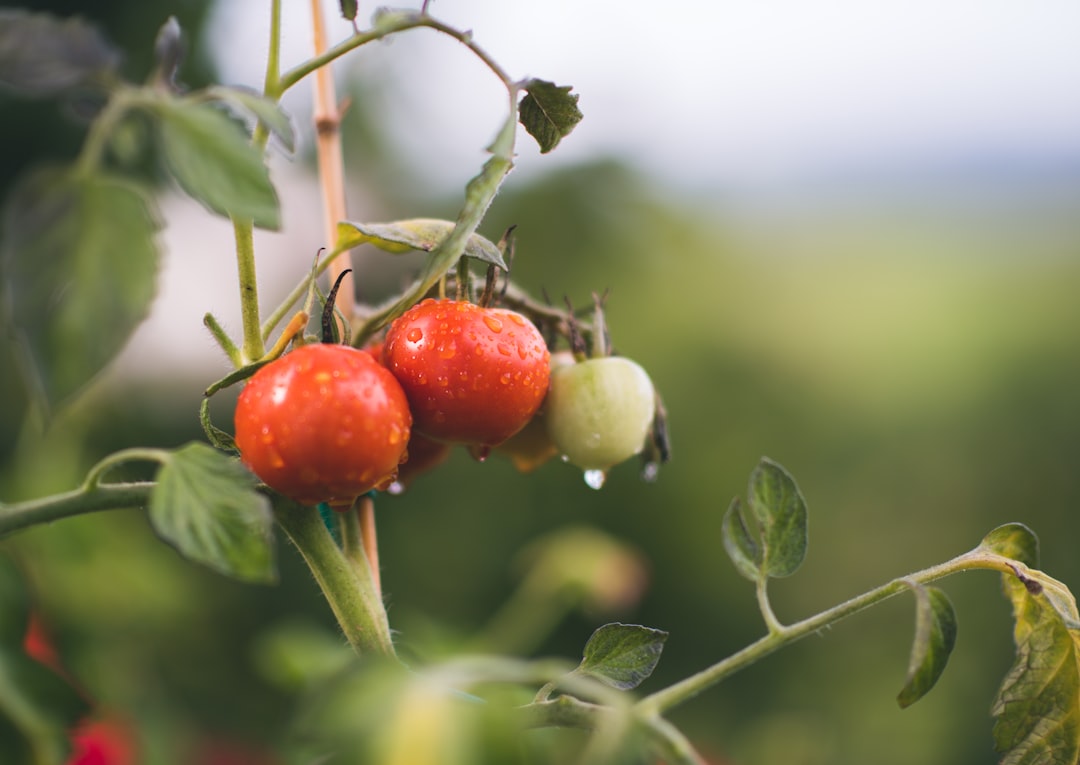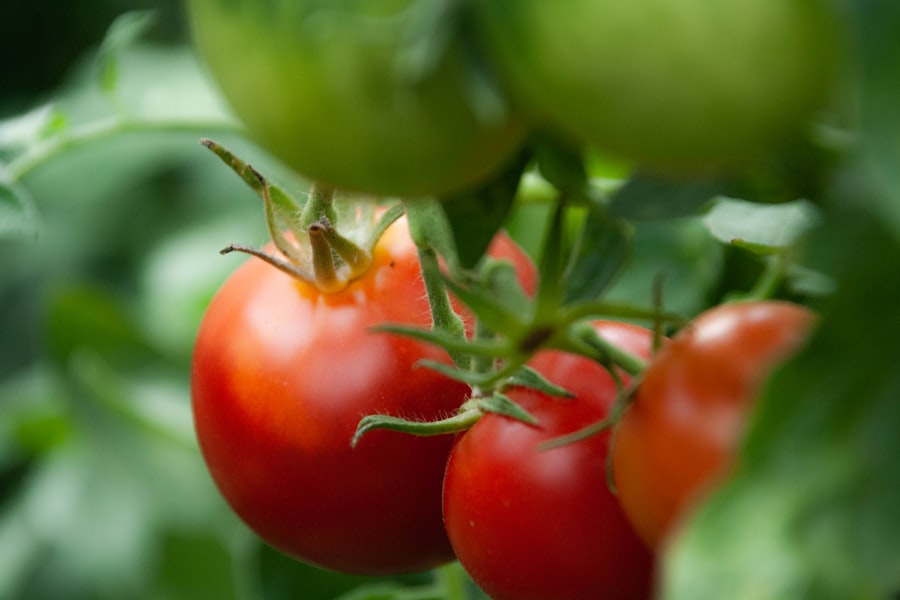Why Are My Tomato Plant Leaves Turning Yellow?

Tomato plants are a popular choice for home gardeners due to their delicious fruits and relatively easy cultivation. However, one common problem that many tomato plant growers face is the yellowing of leaves. This issue can be frustrating and concerning, as it can indicate a problem with the plant’s health and potentially lead to reduced fruit production.
The importance of addressing the issue of yellowing tomato plant leaves cannot be overstated. Healthy leaves are essential for photosynthesis, the process by which plants convert sunlight into energy. When leaves turn yellow, it indicates that something is amiss in the plant’s environment or nutrition. Ignoring this problem can lead to further deterioration of the plant’s health and ultimately result in poor fruit quality or even plant death.
Nutrient Deficiency: Identifying the Role of Nutrients in Tomato Plant Growth
Nutrient deficiency is one of the most common causes of yellowing tomato plant leaves. Tomato plants require a range of essential nutrients for healthy growth, including nitrogen, phosphorus, potassium, calcium, magnesium, and various micronutrients. When these nutrients are lacking in the soil or not properly absorbed by the plant’s roots, it can lead to nutrient deficiency symptoms.
Symptoms of nutrient deficiency in tomato plants can vary depending on which nutrient is lacking. For example, nitrogen deficiency often presents as yellowing leaves starting from the bottom of the plant and progressing upwards. Phosphorus deficiency may cause dark green leaves with purple veins, while potassium deficiency can result in yellowing and browning leaf edges.
Addressing nutrient deficiency in tomato plants involves ensuring that the soil has an adequate supply of all necessary nutrients. This can be achieved through regular soil testing to determine nutrient levels and applying appropriate fertilizers or amendments to correct any deficiencies. Additionally, maintaining proper watering and drainage practices can help ensure that nutrients are effectively absorbed by the plant’s roots.
Overwatering: Understanding the Impact of Excess Water on Tomato Plants
Overwatering is another common issue that can lead to yellowing tomato plant leaves. Tomato plants require a consistent but not excessive amount of water to thrive. When they are consistently overwatered, the roots can become waterlogged, leading to reduced oxygen availability and nutrient uptake. This can result in yellowing leaves and overall poor plant health.
The effects of overwatering on tomato plants can be detrimental. In addition to yellowing leaves, overwatered plants may exhibit stunted growth, root rot, and increased susceptibility to diseases. The excess moisture can create an ideal environment for fungal pathogens to thrive, further compromising the plant’s health.
Signs of overwatering in tomato plants include wilting despite the soil being moist, yellowing or browning leaves, and a foul odor coming from the soil. To prevent overwatering, it is important to ensure that the soil is well-draining and that excess water can freely flow away from the plant’s roots. Watering should be done deeply but infrequently, allowing the soil to dry out slightly between waterings.
Underwatering: The Effects of Insufficient Water on Tomato Plants
| Effect of Insufficient Water on Tomato Plants | Metric |
|---|---|
| Reduced Growth | Height, Stem Diameter, Leaf Size |
| Wilting | Leaf Curling, Drooping, Yellowing |
| Reduced Yield | Fruit Size, Number of Fruits, Flavor |
| Increased Susceptibility to Disease | Early Blight, Late Blight, Bacterial Spot |
| Stress | Reduced Photosynthesis, Reduced Nutrient Uptake |
While overwatering can cause yellowing tomato plant leaves, underwatering can also have a negative impact on plant health. Insufficient water can lead to wilting, reduced nutrient uptake, and ultimately yellowing leaves. Tomato plants require a consistent supply of water to support their growth and fruit production.
The effects of underwatering on tomato plants are similar to those of overwatering. In addition to yellowing leaves, underwatered plants may exhibit wilting, stunted growth, and reduced fruit production. The lack of water can also make the plant more susceptible to pests and diseases.
Signs of underwatering in tomato plants include wilting even when the soil is dry, dry and crumbly soil, and leaves that appear dry and brittle. To prevent underwatering, it is important to monitor the moisture levels of the soil and water the plants regularly. Watering should be done deeply, ensuring that the water reaches the plant’s roots.
Soil pH: How Soil Acidity Can Affect Tomato Plant Health
Soil pH plays a crucial role in tomato plant health. The pH level of the soil determines the availability of nutrients to the plant’s roots. Tomato plants prefer a slightly acidic soil with a pH range of 6.0 to 6.8. When the soil becomes too acidic or alkaline, it can affect nutrient uptake and lead to yellowing leaves.
In acidic soil, certain nutrients like phosphorus, calcium, and magnesium may become less available to the plant. This can result in nutrient deficiencies and yellowing leaves. On the other hand, alkaline soil can lead to iron deficiency, which also manifests as yellowing leaves.
To adjust soil pH for tomato plants, it is important to first determine the current pH level of the soil through a soil test. If the soil is too acidic, adding lime can help raise the pH. If the soil is too alkaline, sulfur or other acidifying agents can be used to lower the pH. It is important to follow recommended application rates and guidelines when adjusting soil pH to avoid overcorrection.
Pests and Diseases: Identifying Common Tomato Plant Pests and Diseases

Pests and diseases can wreak havoc on tomato plants and contribute to yellowing leaves. Common pests that affect tomato plants include aphids, whiteflies, tomato hornworms, and spider mites. These pests feed on the plant’s leaves, sucking out sap or causing physical damage that can lead to yellowing.
In addition to pests, tomato plants are susceptible to various diseases such as early blight, late blight, powdery mildew, and bacterial spot. These diseases can cause yellowing leaves, leaf spots, wilting, and overall poor plant health.
To prevent and treat pest and disease problems, it is important to practice good garden hygiene. This includes removing any infected or infested plant material, regularly inspecting plants for signs of pests or diseases, and using organic or chemical controls as necessary. Additionally, providing proper air circulation and avoiding overcrowding of plants can help prevent the spread of diseases.
Environmental Factors: The Impact of Temperature and Light on Tomato Plant Growth
Environmental factors such as temperature and light can significantly impact tomato plant growth and leaf health. Tomato plants thrive in temperatures between 70°F and 85°F (21°C to 29°C). When temperatures exceed this range, the plants may experience heat stress, which can lead to yellowing leaves.
Similarly, insufficient or excessive light can also cause yellowing tomato plant leaves. Tomato plants require at least 6 to 8 hours of direct sunlight per day to produce healthy foliage and fruits. Insufficient light can result in weak, pale leaves that eventually turn yellow.
To optimize temperature conditions for tomato plants, it is important to provide shade during hot summer days and protect the plants from cold temperatures during cooler months. Using shade cloth or row covers can help regulate temperature and protect the plants from extreme weather conditions.
To ensure adequate light exposure, it is important to choose a sunny location for planting tomato plants. If sunlight is limited in your garden, consider using reflective materials or grow lights to supplement natural light. Regularly pruning the plants to remove excessive foliage can also help improve light penetration and air circulation.
Genetic Factors: The Role of Genetics in Tomato Plant Health
Genetic factors can also play a role in tomato plant health and leaf color. Different tomato varieties have varying levels of resistance to pests, diseases, and environmental stressors. Choosing healthy and disease-resistant tomato plant varieties can help prevent yellowing leaves and promote overall plant health.
When selecting tomato plant varieties, it is important to consider factors such as disease resistance, growth habit, and fruit characteristics. Look for varieties that are known to be resistant to common tomato diseases in your area, as this can greatly reduce the risk of yellowing leaves caused by diseases.
Additionally, selecting indeterminate varieties that continue to produce fruit throughout the growing season can help ensure a steady supply of healthy leaves. Determinate varieties, which produce a large crop all at once, may experience nutrient deficiencies and yellowing leaves towards the end of the season.
Cultural Practices: The Importance of Proper Pruning and Plant Care
Proper pruning and plant care practices are essential for maintaining healthy tomato plants and preventing yellowing leaves. Pruning helps improve air circulation and light penetration, reducing the risk of diseases and promoting overall plant health. Removing excessive foliage also allows the plant to focus its energy on fruit production.
When pruning tomato plants, it is important to remove any suckers that grow in the leaf axils. These suckers divert energy away from fruit production and can lead to overcrowding and poor air circulation. Additionally, removing any diseased or damaged leaves can help prevent the spread of diseases.
In addition to pruning, proper plant care practices such as regular watering, mulching, and fertilizing are crucial for maintaining healthy tomato plants. Watering should be done deeply but infrequently to encourage deep root growth. Mulching helps conserve moisture and regulate soil temperature. Fertilizing with a balanced fertilizer or organic amendments can provide the necessary nutrients for healthy leaf growth.
Tips for Preventing Yellowing Tomato Plant Leaves and Ensuring Healthy Growth
Preventing yellowing tomato plant leaves requires a holistic approach that addresses various factors affecting plant health. By understanding the role of nutrient deficiency, overwatering, underwatering, soil pH, pests and diseases, environmental factors, genetics, and cultural practices, gardeners can take proactive steps to ensure healthy tomato plant growth.
To recap the key points:
1. Address nutrient deficiency by conducting regular soil tests and applying appropriate fertilizers or amendments.
2. Avoid overwatering by ensuring well-draining soil and watering deeply but infrequently.
3. Prevent underwatering by monitoring soil moisture levels and watering regularly.
4. Adjust soil pH to the optimal range of 6.0 to 6.8 for tomato plants.
5. Practice good garden hygiene to prevent and treat pest and disease problems.
6. Optimize temperature and light conditions by providing shade or protection from extreme weather and ensuring adequate sunlight exposure.
7. Select disease-resistant tomato plant varieties to prevent yellowing leaves.
8. Practice proper pruning techniques to improve air circulation and light penetration.
9. Maintain proper plant care practices such as regular watering, mulching, and fertilizing.
By following these tips and addressing the various factors that can contribute to yellowing tomato plant leaves, gardeners can ensure healthy growth and abundant fruit production. Remember that prevention is key, so it is important to monitor plants regularly and take proactive measures to maintain their health. With proper care, your tomato plants will thrive and provide you with a bountiful harvest of delicious fruits.



